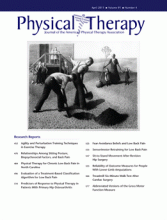Abstract
Background Conflicting evidence exists regarding relationships among sitting posture, factors that influence sitting posture, and back pain. This conflicting evidence may partially be due to the presence of multiple and overlapping factors associated with both sitting posture and back pain.
Objective The purpose of this study was to determine whether the degree of slump in sitting was associated with sex and other physical, lifestyle, or psychosocial factors. Additionally, the relationship between the report of back pain made worse by sitting and the degree of slump in sitting and other physical, lifestyle, or psychosocial factors was investigated.
Design This was a cross-sectional study.
Methods Adolescents (n=1,596) completed questionnaires to determine lifestyle and psychosocial profiles and the experience of back pain. Sagittal sitting posture, body mass index (BMI), and back muscle endurance (BME) were recorded. Standing posture subgroup categorization was determined.
Results Multivariate analysis revealed that the most significant factor associated with the degree of slump in sitting was male sex, followed by non-neutral standing postures, lower perceived self-efficacy, lower BME, greater television use, and higher BMI. Multivariable analysis indicated poorer Child Behaviour Checklist scores were the strongest correlate of report of back pain made worse by sitting, whereas degree of slump in sitting, female sex, and BME were more weakly related.
Limitations Causality cannot be determined from this cross-sectional study, and 60% of sitting posture variation was not explained by the measured variables.
Conclusions Slump in sitting was associated with physical correlates, as well as sex, lifestyle, and psychosocial factors, highlighting the complex, multidimensional nature of usual sitting posture in adolescents. Additionally, this study demonstrated that a greater degree of slump in sitting was only weakly associated with adolescent back pain made worse by sitting after adjustment for other physical and psychosocial factors.
Footnotes
Professor O'Sullivan, Dr Smith, and Professor Straker provided concept/idea/research design, data analysis, project management, and fund procurement. All authors provided writing and consultation (including review of the manuscript before submission). The authors thank the Raine study participants and their families, as well as Rosemary Austin, Lee Clohessy, Alex D'Vauz, Monique Robinson, Nick Sloan, and Diane Wood for collection of data.
The authors acknowledge funding the Australian National Health and Medical Research Council (project 323200, program 003209), the Telethon Institute for Child Health Research, the Raine Medical Research Foundation at the University of Western Australia, Healthway, the Arthritis Foundation of Western Australia, and the Arthritis Foundation of Australia. Dr Smith and Professor Straker are supported by National Health and Medical Research Council fellowships.
- Received May 11, 2010.
- Accepted December 16, 2010.












